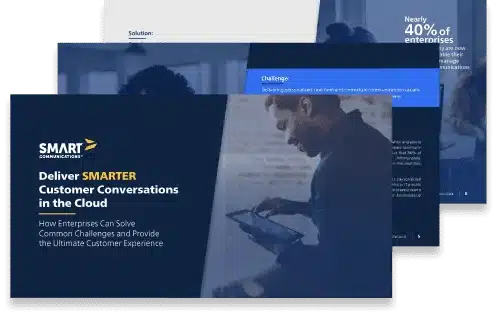Improving Patient Engagement: How the Conversation Cloud™ Leads the Way

By John Zimmerer, VP of Healthcare Marketing at Smart Communications
Digital transformation in healthcare presents a mixed landscape, according to analyst firms IDC, Forrester, and Gartner1. These initiatives aim to enhance customer engagement, streamline processes, and improve patient outcomes, yet, per Gartner, as many as 60% fall short of expectations.
Gartner points out that many of these efforts result in “optimization” rather than true “transformation”. Genuine digital transformation goes beyond digitizing existing processes – it reinvents them. This often involves transitioning from legacy point solutions to enterprise-wide platforms, typically cloud-native SaaS solutions.
This blog explores how Smart Communications’ The Conversation Cloud helps providers reinvent patient engagement, forms and communication processes. Our solutions that make up the Conversation Cloud platform provide the convenience, personalization, and the data security your patients desire, while also aiming to increase health equity and improve outcomes.
The Burden of Forms on Patient Engagement
Forms are ubiquitous in healthcare, and patients despise them. They find these forms time-consuming, repetitive, and often riddled with irrelevant questions.
This dissatisfaction affects both your top and bottom lines. A survey of physicians and patients found that:
I would submit that a good chunk of that in-office waiting time is largely due to forms. When visiting a healthcare provider, patients may encounter (and staff are often asked to help with) various forms, including:
- Scheduling the appointment
- Pre-registration and intake
- Consent to treatment
- Medical record release authorization
- Authorization of representative
- Financial assistance application
Many providers still rely on paper forms to collect patient information. Scanning and using optical character recognition (OCR) on these forms can be cumbersome and carries the risk of data loss (no OCR program claims 100% accuracy) and breaches, since paper is portable.
Some providers have moved to fillable PDF or HTML forms, but these often fall short of patient expectations. Patients want forms that pre-fill known information, provide a consistent experience across devices, allow progress to be saved, and ask only relevant questions.
Our research identified these as top reasons why patients abandon forms.
Typically, healthcare-related forms are difficult to modify without IT help and are challenging to manage and control. The software used to create forms often lacks integration with core systems or with third-party services (e.g., address verification or e-signature solutions) or has limited functionality. For example, most cannot support multiple parties contributing information, route to multiple signatories, or chain forms together.
For instance, if a medical release form is being completed on behalf of another person, an appointment of representative forms is also required. Similarly, multiple admission forms may need to be combined into a single digital signing session to streamline the process for the patient and reduce the provider’s e-signature costs.
Outdated Patient Forms Are a Symptom of a Larger Process Problem
Forms are always part of a larger process: they collect data for purposes such as informing a treatment plan or managing revenue cycles.
Examples of these larger processes include:
- Admissions
- Care coordination
- Referral management
To truly digitally transform these crucial processes, simply moving to electronic forms is insufficient and only scratches the surface. Beyond the forms, supporting workflows must be built and automated. Additionally, the data gathered needs to be standardized and disseminated to the appropriate systems for reuse. This requires a single enterprise platform that integrates seamlessly with your existing systems, rather than a collection of point solutions.
SmartIQ™, the forms automation and data collection part of The Conversation Cloud platform, meets all these requirements.
How You Can Benefit from SmartIQ and Improve Patient Engagement
-
Decreased abandonment rate. Easy-to-access, simple, and individually relevant forms increase submission rates.
-
Shortened time to completion. Faster form completion leads to quicker patient care, improved compliance rates, better health outcomes, and shorter revenue cycles.
-
Elimination of incomplete or inaccurate data. Structured data removes the need for scanning, OCRing, or rekeying forms, reducing the risk of missing or incorrect data.
-
Lower administrative expenses. Reduced time spent on paperwork and follow-ups makes staff more productive and your organization more profitable.
-
Improved security and compliance. A secure, HIPAA-certified SaaS platform keeps PII and PHI safe, minimizing risk and reputational damage.
Loyalty and the Consequences of Poor Patient Communications
Patient communications—from appointment reminders to treatment summaries and statements—are predominantly handled by the electronic health record (EHR), practice management, or similar health information systems. However, these systems often have gaps or limitations, particularly in handling revenue cycle management communications.
Our recent healthcare benchmark research found that the importance of healthcare communications continues to increase. Globally, 85% of respondents said that communications are either somewhat or very important to patient experience, up from 81% the previous year.
However, only 46% of patients rated the healthcare communications they received as very good or excellent. They noted that clarity, accuracy, and timeliness of communications significantly impact their trust in healthcare organizations.
Alarmingly, 66% of respondents said they would switch providers if the quality of healthcare communications didn’t meet their expectations, up 15% from the previous year.
Healthcare organizations need to operate efficiently, but this is strained by staffing shortages and a patchwork of point solutions. Gartner, IDC, and others identify technical debt from maintaining legacy solutions as a barrier to operational efficiency. This is driving many healthcare organizations to move to cloud solutions.
Analyst firms recommend adopting artificial intelligence (AI) to address staffing shortages and productivity challenges. While healthcare organizations have been slow to adopt generative AI (GenAI), 47% of surveyed healthcare consumers see its potential to improve communications, although 66% have concerns about its use. While we provide several AI-powered features, we recommend taking a cautious, considered, and contained approach to leveraging GenAI in your organization.
SmartCOMM™, the communications management part of The Conversation Cloud, is an ideal solution for managing your dunning letters, payment plans, invoices, and statements. It integrates with health information systems, patient and provider portals, mobile applications, chatbots, and other channels and systems, providing a single platform for managing content and communications.
How You Can Improve Patient Engagement with SmartCOMM
-
Enhance clarity. Use built-in AI-powered content analysis and enhancement tools to improve the readability of patient communications, increasing compliance and reducing complaints.
-
Improve accuracy. Integrate with core systems and use simple-to-construct business logic to tailor communications with patient-specific information.
-
Ensure timeliness. Connect with patient touchpoints to trigger timely communications through preferred channels such as web, email, SMS, or print.
-
Address equity. Adapt communications to your population’s language, literacy, and ability levels, ensuring compliance with Section 508 and other accessibility standards.
-
Increase efficiency. Consolidate communications onto a single SaaS solution accessible across your organization, reducing costs and improving efficiency.
Conclusion
Turn to Smart Communications as your trusted partner for digitally transforming your patient engagement and communications. Our Conversation Cloud helps refactor your patient forms and rationalize your content, transitioning from managing transaction-driven touchpoints to cultivating ongoing customer conversations.
It’s Time to Get Smart!
Contact us today to discuss your unique needs or to see a demonstration of how our solutions can help.
1 U.S. Healthcare Payers 2024 CIO Agenda Insights and Data. Available online.



